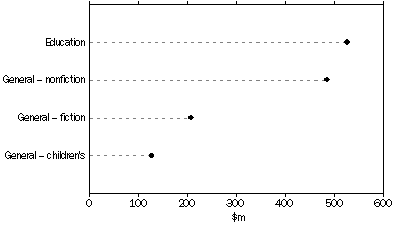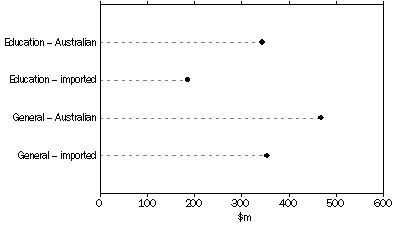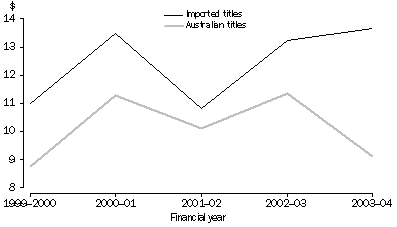INTRODUCTION
This publication presents data, in respect of 2003-04, for businesses which had either book publishing as their main activity (book publishers) or generated $2m or more in income from book publishing, although this was not their main activity (other major contributors). For other major contributors this publication only includes data for their book publishing activity. So, for example, total income of $1,560.6m includes: all income from the 234 businesses whose main activity was book publishing; and for those 10 businesses where book publishing was not their main activity, it includes only the income derived from book publishing activity.
OVERVIEW
For 2003-04, 234 businesses were identified as book publishers while a further 10 were other major contributors. These 244 businesses sold a total of 128.8 million books, primarily to book retailers, earning income of $1,353.2m. With a total income of $1,560.6m, expenses of $1,404.4m and a reduction in inventories of $4.2m, the overall operating profit before tax of these businesses was $152.1m (table 1).
The 20 largest book publishers (in terms of income) generated 77% ($1,198.3m) of the total income for book publishers and other major contributors. Similarly, the 20 largest book publishers achieved 78% ($1,057.8m) of the value of total book sales and sold 76% (97.7 million) of all books. Their share of the total expenses was 77% ($1,083.7m) (table 1).
Book publishers and other major contributors reported an average profit margin of 9.7%. For the largest 20 book publishers, the profit margin was 9.5%. For other book publishers, the profit margin was 12.7% while other major contributors had a profit margin of 1.4% for their book publishing activity. The 20 largest book publishers contributed $369.2m to industry value added, which is a measure of the value which an industry adds to the overall economy. This was 72% of the total industry value added for book publishing activity (table 1).
At the end of June 2004, book publishers and other major contributors employed 5,300 people, of whom 3,547 (67%) worked for the 20 largest book publishers (table 1).
INCOME
Sales of books contributed $1,353.2m (87%) to the total income of book publishers and other major contributors. This included an amount of $541.3m for the sales of imported titles. Income from services ($72.9m) was the second highest contributor to total income, followed by sales of other goods ($68.6m) by book publishers (table 4).
EXPENSES
The major components of total expenses ($1,404.4m) were printing costs, wages and salaries, and the cost of imported books. Printing costs accounted for $316.6m (23% of total expenses), with printing in Australia comprising $143.6m and overseas $173.0m. Wages and salaries contributed $266.1m (19%) to total expenses, while another $53.9m (4%) was spent on other labour costs. Businesses spent $202.0m (14% of expenses) on imported books (table 5).
METHOD OF SALE
The majority of book sales (77% or $1,047.2m) were to retailers and other book distributors for on-selling to individuals and organisations. The remaining sales (23% or $305.9m) were transacted directly with the final consumer (table 11). An estimated $7.3m (1%) of total book sales were made through the Internet (table 1).
SALES OF BOOKS BY CATEGORY
Of the 244 businesses identified as book publishers and other major contributors, 133 were involved mainly in publishing books of general content while the remainder were predominantly publishing educational books (including professional and reference books) (table 3).
Book publishers and other major contributors sold $819.6m worth of printed books of general content covering nonfiction ($485.3m or 59%), fiction ($207.6m or 25%) and children's books ($126.7m or 16%). A further $526.1m worth of sales were for printed educational books, while sales of electronic books (which includes audio books) totalled $7.5m (table 9).
SALES OF PRINTED BOOKS BY CATEGORY

Many books are published as a hardback or trade paperback before being reissued as a mass-market paperback. The value of sales of general trade paperback books was $307.3m, compared with $273.7m for sales of general mass-market paperback books and $238.6m for general hardback books (table 9).
New titles accounted for 53% of total book sales ($719.8m) (table 12). Australian titles accounted for 60% ($811.9m) of total book sales, representing 65% ($343.4m) of educational book sales and 57% ($468.5m) of general book sales. Of all sales of Australian titles, 96% ($780.6m) originated in Australia, while the remaining 4% ($31.3m) were acquired from overseas under separate rights agreements (table 13).
SALES OF BOOKS BY CATEGORY AND ORIGIN OF TITLE

SALES OF AUSTRALIAN AND IMPORTED BOOKS
There were 84.4 million printed books sold which were originated and published by Australian book publishers and other major contributors. These books generated income of $750.5m, giving an overall average selling price for Australian originated books of $8.89 per book. Of such books, professional and reference books had the highest average selling price ($30.08), closely followed by tertiary education books ($29.62) (table 14).
There were 39.5 million imported printed books sold by Australian book publishers and other major contributors, at a value of $539.5m, with an overall average selling price per book of $13.67. On average, tertiary education books were the most expensive ($32.63) while children's mass-market paperbacks were the cheapest ($5.67) (table 14).
Overall, sales of Australian originated titles to book retailers, other distributors and to final consumers generated more income ($750.5m) than the sales of imported titles ($539.5m). Income from printed educational books, originated and published by Australian book publishers and other major contributors, was $313.2m, 69% more than the income from imported books ($185.6m). For nonfiction books, income from Australian originated publications ($310.1m) was 75% higher than the equivalent figure for imports ($177.1m). However, income from Australian originated fiction books ($73.1m) was lower than that for imported fiction ($116.6m). This was also the case for children's books, where the income from imported books was $60.2m, compared with $54.2m from Australian originated products (table 14).
NEW AUSTRALIAN TITLES PUBLISHED
There were 8,602 new Australian titles published during 2003-04, of which 8,334 (97%) were printed titles originated by Australian book publishers and other major contributors. Over one-half of these printed titles (55% or 4,610) were educational. Of the 3,724 general-content titles, 44% were trade paperbacks, 40% were mass-market paperbacks and the remaining 16% were hardbacks (table 15).
EXPORTS
Export sales of books amounted to $190.5m or 14% of total book sales. Re-exports contributed $7.8m to this amount (table 9).
The United States of America (USA) was the biggest single market for books exported from Australia, with sales to the USA totalling $57.8m, almost one-third (30%) of the total value of exports. Other notable markets were New Zealand ($42.2m) and the United Kingdom ($33.5m) (table 10).
The total sales of rights to businesses in other countries was $5.0m (table 10).
EMPLOYMENT
At the last pay period ending June 2004, book publishers and other major contributors employed a total of 5,300 people (employment numbers for other major contributors refers only to their book publishing activity). Of these, 1,848 (35%) were males and 3,452 (65%) were females. Just over three-quarters (76% or 4,002) of the 5,300 were full-time, permanent employees. An additional 380 people (7%) were employed permanently on a part-time basis and 708 people (13%) were employed as casuals, while 212 (4%) were working proprietors and partners (table 8).
STATE AND TERRITORY DATA
In 2003-04, book publishers and other major contributors that were based, or had their head office, in New South Wales accounted for 51% ($684.9m) of total book sales. Victoria's contribution was 43% ($580.4m) of total book sales (table 2).
CHANGES OVER TIME
A comparison of survey data for 2002-03 and 2003-04 shows significant change in only a few of the data items. The value of the operating profit before tax increased by 75% ($65.2m) from $86.9m in 2002-03 to $152.1m in 2003-04. Average wages and salaries per employee rose 9% between 2002-03 and 2003-04, to $52,300 (table 16). The profit margin increased over the same period by 4.2 percentage points, from 5.5% to 9.7%.
The main reason for the increase in profit margin was a decline in the average expenses per business (from $6.0m in 2002-03 to $5.8m in 2003-04), while the average income per business remained steady at $6.4m. A major decrease in expenses (17%) was the landed costs of books imported (down from $243.6m in 2002-03 to $202.0m in 2003-04), while royalties and fees paid decreased by 11% ($11.7m). In addition, other operating expenses decreased by 26% ($75.4m) over the same period.
Several data items are comparable across the eight collection periods since the survey began in 1994 (see paragraphs 22 to 23 of the Explanatory Notes). Figures for 2003-04 show a small (statistically insignificant) decrease in the sales of Australian titles and increase in the sale of imported titles. Over the ten-year period, the value of export sales of books has increased, with export sales of books in 2003-04 ($190.5m) 134% higher than in 1994 ($81.1m). Over the same period, sales of Australian titles increased by 66%, from $487.7m in 1994 to $811.9m in 2003-04 (table 17).
Since 1999-2000, the average selling price of books has fluctuated. Imported titles have remained more expensive than Australian titles over this period. Between 2002-03 and 2003-04, the average selling price of Australian titles dropped (from $11.36 to $9.10), while imported titles rose slightly in price (from $13.25 to $13.68).
AVERAGE SELLING PRICE PER BOOK

 Print Page
Print Page
 Print All
Print All